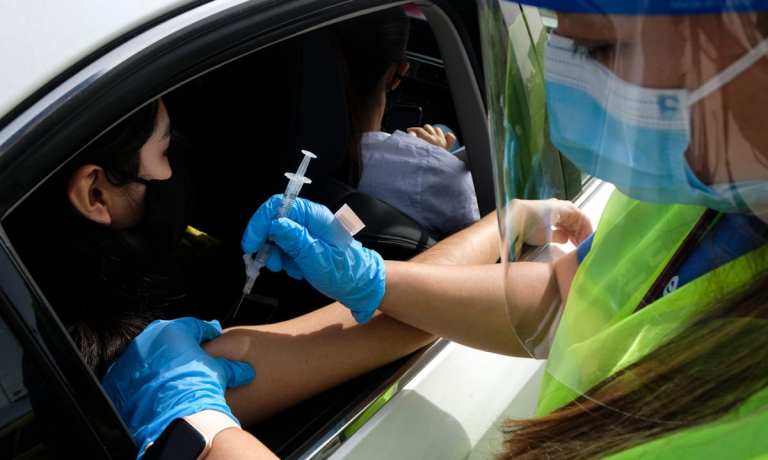How The Race Between Vaccines And Infection Rates Could Impact Reopening

The last leg of the race to make COVID-19 a thing of the past has reached a frustratingly slow phase, as new, and more infectious, variants of the disease are popping up internationally, speeding up the spread at the same time that vaccines are rolling out.
And in some places, it seems, the virus is holding onto the edge in the race. According to reports, the EU is now dealing with what it has identified as its third COVID-19 wave. A handful of countries have reintroduced lockdowns, including France, Poland and Ukraine, which as of last weekend had put new measures into place for the next several weeks. The wave of partial lockdowns comes in the face of rapidly spiking figures. France reported over 30,000 new daily cases on Sunday, bringing the country’s total number of infections to over 4.2 million.
Germany, meanwhile, is reportedly considering putting lockdown measures into place. The nation’s COVID incidence rate has exceeded 100 cases per 100,000 people, a ratio that the German government had previously identified as a benchmark for halting the lifting of lockdown measures to prevent further spread.
The reinstatement of such lockdowns in Europe is, unsurprisingly, controversial, as yet another slowdown will present serious setbacks to the economic recoveries struggling to get underway.
The question in the U.S. is whether the EU spike foreshadows a similar event in the U.S. — earlier in the pandemic, the U.S. has trailed Europe by a few weeks when it comes to COVID case surges — and whether such a surge in the States would similarly impede the possibility of reopening. In fact, there is already evidence in places like New Jersey that such an event is already underway. Reports indicate that the state will likely pause its reopening plans as COVID-19 cases begin to rise, according to Gov. Phil Murphy. As of Sunday (March 21), the state’s seven-day average of new COVID-19 cases had increased to just over 4,000 per day — a more than 10 percent jump from the previous week, leading the nation in new cases per capita over the past week, according to data from the Centers for Disease Control and Prevention.
“My guess is, we won’t be opening up further capacity for some time now because of … the caseload,” Murphy told the media, adding that he thinks things should improve as the weather gets warmer and more people in the state get vaccinated.
And vaccination could be the key difference maker between the U.S. and the EU when it comes to seeing a third wave of infections and possibly another round of shutdowns. Vaccine rollout in the EU has been notably sluggish due to manufacturing issues and supply snags. EU officials were criticized for bulk-ordering coronavirus vaccines later than the U.K. and U.S., creating supply issues across the continent and fights about the export of drugs manufactured in the EU. The U.S., on the other hand, has passed the 100 million vaccine goal set by the Biden administrations for its first 100 days in office as of last week, and is pushing toward its next goal of 200 million.
Will the more aggressive vaccine push head off a next COVID wave of the scale now seen in Europe? That remains a jump ball. It does seem worth noting, however, that in the face of vaccines rolling out and cases climbing globally in parallel to each other, consumers are moving their target in terms of what it will take to return to their pre-pandemic habits.
When PYMNS asked that question back in November of 2020, 69 percent of survey respondents expressed that a vaccine was the primary thing they were looking for in terms of getting back to normal. By February 2021, that had slipped to 56 percent. In November 2020, a decline in case counts was nearly tied with a vaccine, with 70 percent of consumers noting it as a primary factor; by February of 2021, that had also slipped, but not by quite as much, with 58 percent of consumers still marking it as primary.
It will also be interesting to note whether the uptick in COVID-19 cases and the still looming possibility of another round of lockdowns will dampen the burgeoning optimism about when a full reopening might happen. The average U.S. consumer believes that the pandemic would end in 289 days if vaccines were not available, and that widespread vaccinations will lead to the pandemic ending in 252 days — 37 days sooner than would otherwise be possible. This would mean being able to reenter the physical world without restrictions by January 2022 instead of April 2022, as consumers expected previously.

Unfortunately, as has often been the case during COVID-19, the only thing to do is wait and see whether faster vaccinations will be enough to hold off a third wave stateside, thus keeping consumer optimism elevated.